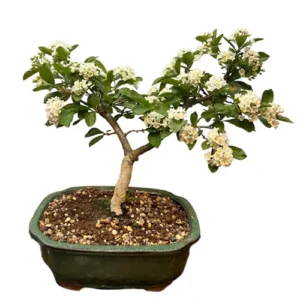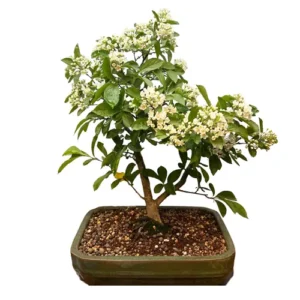Tilia
Lime Bonsai
Native to Western China, Northern Europe and North America. These broad-leaved, deciduous trees turn a sparkling golden in the Autumn. Its scented flowers and suitability to many styles make this a desirable bonsai.
Lime Bonsai Care Tips
Placement
This bonsai can handle hard frost so they need no winter protection. Lime enjoys full sun and partial shade.
Watering
During the summer, Lime bonsai appreciates lots of water. In Spring and Autumn a little less so. During the winter keep it just moist.
Feeding & Fertilising
Feed every two weeks across the growing season. In the middle of summer, feed with a semi-strength general fertiliser. Be mindful that over-feeding will encourage large leaves.
Pruning & Wiring
Pruning should take place at the start of Spring and in the middle of Summer. Larger leaves should be pruned in the summer as this can produce smaller leaves.
Early Spring is the best time to wire, though it can be done at any time. Be mindful of Lime bonsai’s soft bark, do not keep the wire on for long as this will mark the tree. We recommend using wires with a thickness that matches the thickness of the branch: if the wire you choose is too thick you will damage the bark. If it is too thin, it won’t be effective.
Repotting
Repotting your tree is an important way to provide a fresh and suitable soil mix and ensure appropriate root health. Repot in early spring. Lime Bonsai require repotting every 2-3 years and is best done in the Spring. Be careful not to repot too frequently but do not leave longer than 5 years.
Trees that are ready for repotting will require root pruning, a suitable new pot and appropriate soil mix.
When repotting, do not cut back the root mass by a large amount, and choose a well-draining soil mix that has a neutral or slightly higher PH value of 5-6 but not over 7. We tend to use a mixture of different speciality bonsai soils on our trees. Every species is different so please contact us for free soil-mix advice or to take advantage of our repotting service.
Bonsai trees aren’t only magnificent additions to an indoor oasis, they are more than capable of standing out in any garden. Many Bonsai species are incredibly hardy and withstand nature’s colder and damper turns with aplomb making them worthwhile outdoor plants. We have an extensive library of care guides for outdoor bonsai trees. It’s not about selecting the perfect bonsai, it’s about selecting the perfect bonsai for you.
Lime Bonsai - Typical Queries
Is Lime bonsai suitable for beginners?
As a species relatively easy and straightforward to care for, Lime bonsai is a suitable beginner’s tree.
How to propagate Lime bonsai?
Lime bonsai can be propagated with seeds and cuttings. Seeds need stratifying for approximately 3 to 5 months. Afterwards they should be sown outside in Spring, or in Autumn when ripened. Ripewood cuttings can be used toward the end of summer.
Do Lime bonsai get pests and diseases?
Lime bonsai can be susceptible to aphids, scale, gall mites and spider mites. While most can be taken care of manually, an insecticide may be necessary. Watering can bring on problems, lead spots can be brought on with frequent watering, and root rot is likely to occur with overwatering.





















